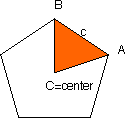
I went to School in Berkeley with Donald Chakerian.
I tracked him down in cyberspace and sent him a note about eδ being a root of 1−3x+3x4−x5.
He immediately noted that τ + √τ is the same root of that polynomial!
τ = (1 + √5)/2 and τ2 − τ − 1 = 0.
Here is his development:
If τ = (1 + √5)/2 is the Golden Ratio, then τ + √τ = 2.89005363... is a root of x5 − 3x4 + 3x − 1. In fact
x5 − 3x4 + 3x − 1 =
(x−1)(x4 − 2x3 − 2x2 − 2x + 1)
= (x−1)(x2 + (2τ − 2)x + 1)(x2 − 2τx + 1), and
x2 − 2τx + 1 = (x − (τ + √τ))(x − (τ − √τ))
Looking in David Kay‘s College Geometry (1969 edition) on page 320, Ex 11, one finds an “equation of Gauss for hyperbolic geometry” that says
cosh(c/2)sin((A + B)/2) = cosh((a − b)/2)cos(C/2).
| in the ∆ABC labeled as on the right |  |
In particular, if ∢A = ∢B = 45° and a = b, this gives
cosh(c/2)/√2 = cos(C/2)
| In a right angled regular hyperbolic pentagon, look at the shaded area | 
|
| Note that for the shaded ∆ABC we have ∢A = ∢B = 45°, ∢C = 72° and BC = AC. Thus the side c of the pentagon satisfies |
cosh(c/2)/√2 = cos 36° = τ/2
or cosh(c/2) = τ/2.
But if
| c = ln(τ + √τ) |